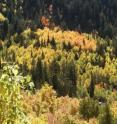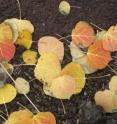Western aspen trees commonly carry extra set of chromosomes
A large proportion of aspen in the western U.S. sport an extra set of chromosomes in their cells, a phenomenon termed triploidy, according to new research published Oct. 31 in the open access journal PLoS ONE by Karen Mock from Utah State University and colleagues at several other institutions. In some areas of southern Utah and Colorado, over 60% of aspen trees are triploid. Though triploid trees are not uncommon, this genetic anomaly can cause altered physical traits including sterility or reduced fertility. Although a triploid aspen clone may reproduce with root suckers, the scientists say, it is unlikely to produce viable seed.
Mapping the rates of triploidy in aspen to latitude, glacial history and regional variation in climate, the researchers found that these rates were highest in unglaciated, drought-prone regions. Wolf, professor in USU's Department of Biology, notes triploid plants often have larger cells, which might affect how plants cope with different conditions. "It is possible triploid aspen can better absorb water than diploids and are therefore better suited to withstand dry conditions, but they may be especially vulnerable to severe drought," he says.
Iconic fall foliage of the north-western forests, aspen populations have been declining in recent years; their high mortality rates have been attributed to drought, insect pests and a mysterious syndrome termed "Sudden Aspen Decline" (SAD). The new research is based on data collected over more than eight years by the Forest Service, a NASA Biodiversity program, and several researchers and volunteers.
Lead author on the study Mock says, "Though our findings come from many years of study, they provide an important starting point as we go forward. What we're learning will help us understand both the past and the future of aspen in the West."
Source: Public Library of Science
Other sources
- Western aspen trees commonly carry extra set of chromosomesfrom Science DailyThu, 1 Nov 2012, 14:00:45 UTC
- Western aspen trees commonly carry extra set of chromosomesfrom PhysorgThu, 1 Nov 2012, 0:00:30 UTC

